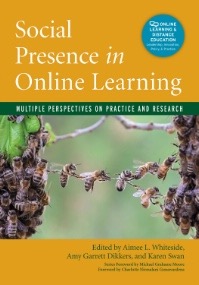online learning
Select an item by clicking its checkbox
Two years ago I decided to kill voice-over PowerPoint as an online teaching tool. It wasn’t nearly as hard to kill as I thought it would be. And, for good reasons, I won’t go back. If you are new to online teaching, someone will inevitably suggest voice-over PowerPoint ...
We can boil successful strategic planning around distance education down to three things. First, know how to create lots of ways to use the digital environment for effective teaching and learning. Second, know your potential students. Third, bring the two together: develop a set of scenarios in which to leverage ...
I love the face-to-face learning environment. Even when I stood before my first class, uncertain if I knew enough to teach for 10 minutes much less 75, I thrived on the energy in the room. I also felt somewhat at ease with the basics, given I could draw on a lifetime of ...

Teaching the World: Foundations for Online Theological Education
Date Reviewed: April 17, 2018
Teaching the World is a welcome volume on online theological education that seeks to ground educational practice with a theological foundation. The work is a critically needed guide that directs leaders and administers in developing online education programs. Readers will find practical insight on program development on three levels: framework, faculty, and classroom.
An introductory chapter entitled, “Past Patterns and Present Challenges in Online Theological Education,” describes the delivery of theological education from the early days of correspondence in the eighteenth century to the current practice of providing multimedia curricula fully online. After advocating the legitimacy of online theological education, the authors maintain that educational institutions have often not built their online programs on theological foundations. Instead, they have unwittingly overlooked this step in their rush to launch programs for primarily pragmatic reasons – increased enrollment and profitability.
The balance of the book is divided into three sections. Section I, “Better Foundations for Online Learning,” examines the role of the Pauline Epistles in theological education, ministry preparation, and spiritual formation from a distance. The authors argue that Paul\'s Epistolary practice provides biblical support for theological education from a distance and an example of how to deliver it. Subsequent pages integrate “social presence theory” with Paul\'s epistolary practice, resulting in a conceptual framework for online program development.
Section II, “Better Faculty for Online Learning,” provides theological guidance for faculty roles in online programs. Here the authors argue for faculty who: (1) emphasize the spiritual formation of students over the mere transfer of knowledge, (2) demonstrate the ability to leverage the medium of online education to accomplish the desired outcomes for students, and (3) model the theological and professional standards for ministry. In such an environment, online faculty members embody the values of the institution and effectively facilitate the desired outcomes of programs.
Section III, “Better Practices in the Classroom,” maintains that the students’ ministry contexts make effective online learning possible. Students in online programs are typically older and engaged in some form of ministry. Consequently, online programs should incorporate adult learning theory and facilitate learning in the student’s ministry context – the local church serving as an active partner in ministry preparation.
A concluding chapter, “To Teach, to Delight, and to Persuade,” argues that online programs are not a replacement for residential programs, but are a means for developing stronger partnerships for ministerial preparation. This book’s emphasis on using theology as a conceptual framework for online theological education is its conspicuous strength.
Teaching the World: Foundations for Online Theological Education presents a grand vision for online theological education that is particularly valuable for leaders of theological schools who seek to develop online programs that are effective in fulfilling the educational outcomes of their institutions.

Social Presence in Online Learning - Multiple Perspectives on Practice and Research
Date Reviewed: December 12, 2017
As post-secondary institutions, theological schools continue to participate in various forms of online learning, and the criticism (or question), “It’s not really the same as being in a classroom with a real instructor” is commonly heard. The simple reply to this concern is the concept of social presence. Starting with the initial definition of social presence from Short, Williams, and Christies (1976), this compilation of articles attempts to summarize the historical perspectives and present the current state of discussion, recognizing the constant updating of online course options.
The authors successfully present the historical perspectives, grouping them in three broad categories – as technologically facilitated, as learners’ perceptions, and as critical literacy. However, the chronological and developmental approach leaves the reader realizing the earlier chapters have minimal application to current teachers and learners since the understanding of social presence and the technology used have changed so dramatically. The initial discussions about social presence whether through computer-mediated communication or later within the community of inquiry framework were informative, but the reader quickly realizes that the later frameworks and models have improved. Thus the earlier discussions in the book are of little value for today’s teaching-learning environment. In essence, only the last section is relevant, except as historical background.
The editors demonstrate their breadth of knowledge of the literature and are involved with and connected to the latest research in social presence. A useful chapter (11), “Cultural Perspectives in Social Presence,” provides valuable guidelines for communicating effectively in a multi-cultural learning context. Multiple examples explain how one subset of students find an online learning activity contributes positively to social presence while those of another culture find it impacts social presence negatively. Variations in anonymity, informal chat, self-disclosure, trust building, and conflict resolution are considered. The chapter concludes with useful tips for monitoring and mediating communication which could be misunderstood because of cultural differences.
Likewise, various practices for building social presence into discussions, feedback, and interactions are shared throughout the book. The literature reviewed includes a range of educational levels from K-12 and post-secondary as well as a range of disciplines. The final section provides interesting chapters (17 and 18) about the future of online learning and incorporates social presence into various models of instruction. They suggest social media tools enable instructors to incorporate cohesive and affective elements into courses to enhance social presence. The authors conclude, “Never stop learning because life never stops teaching” (210).
The information shared is relevant for any faculty member teaching online, including theological and religious studies professors. While the final chapters contain valuable tips as noted above, I cannot recommend the book as a whole since it is predominantly a historical overview of the concept of social presence. Though it contains various up-to-date strategies in the closing chapters, it was tedious for the reader to sift through the detailed literature for meaningful insights.


